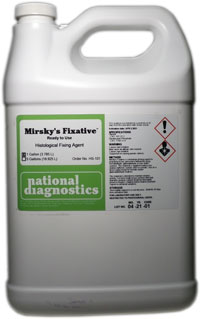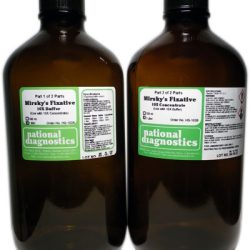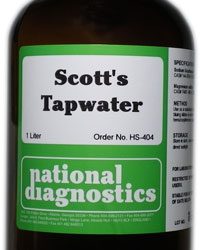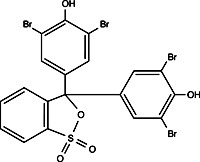Histology
Mirsky’s Fixative (ready-to-use)
$35.00 – $144.00
- Saponin/Glyoxylate Fixative
- Preserves Immunohistological Activity
- Contains No Formaldehyde
- Fast-Acting
Description
- Saponin/Glyoxylate Fixative
- Preserves Immunohistological Activity
- Contains No Formaldehyde
- Fast-Acting
Mirsky’s Fixative is a superior fixing agent for use in immunohistological and immunocytological protocols. Mirsky’s Fixative contains no formaldehyde or glutaraldehyde. Therefore, it has considerably reduced toxicity and virtually no odor. Mirsky’s Fixative is neutral, buffered, and isotonic (308 milliosmoles). Additionally, Mirsky’s Fixative does not contain toxic or hazardous buffers such as cacodylate or barbital. Hardening or shrinkage of tissue is considerably reduced.
Double reactive sites afford excellent crosslinking properties while maintaining sample enzyme activity. Samples processed in Mirsky’s Fixative for light microscopy can subsequently be used in electron microscopy procedures. Special buffer systems may be used in place of the buffer provided.
Mirsky’s Fixative is normally distributed as a concentrated two-bottle system, although high throughput laboratories often use the single bottle ready-to-use format. The two-bottle system is comprised of Mirsky’s Fixative 10X Concentrate and Mirsky’s Fixative 10X Buffer. To reconstitute to working strength, add 1 part Mirsky’s Fixative 10X Buffer to 8 parts distilled or deionized water, mix thoroughly, then add 1 part Mirsky’s Fixative 10X Concentrate and mix again.
The two-bottle system has a shelf life of 12 months while the ready-to-use format has a shelf life of 30 days.
Method:
Use as a replacement for formalin and/or glutaraldehyde fixatives in immunohistological and immunocytological staining protocols. Tissue size is unlimited as long as the sample is no thicker than 0.5 cm in at least one plane to assure uniformity of tissue penetration. The gross visual appearance will be different than in formaldehyde and tissue may seem ‘raw’. This is due to double site binding of the fixative with a resultant reduction in tissue shrinkage. Microscopic examination of tissue morphology will be noticeably improved. This material is intended to maintain enzyme and antibody activity. For best results, tissue sections of high digestive enzyme content should be thoroughly rinsed in saline solution before fixation (e.g. trypsin in intestinal samples). Once fixed, tissue may be retained in Mirsky’s Fixative and ethanol indefinitely.
Additional information
| Weight | 0.1 lbs |
|---|---|
| Dimensions | 15 × 10 × 13 in |
| Size | 1 gal, 5 gal |
Safety Overview
Safety Summary (see SDS for complete information before using product):
Appearance and Odor
Clear liquid.
EMERGENCY OVERVIEW – IMMEDIATE HAZARD
WARNING! HARMFUL IF SWALLOWED OR INHALED. CAUSES IRRITATION TO SKIN, EYES, AND RESPIRATORY TRACT. Irritating to eyes and skin. In case of contact with eyes, rinse immediately with plenty of water and seek medical advice. After contact with skin, wash immediately with plenty of soap and water.
- Working Safely with Fixatives
- Tissue Processing for Electron Microscopy
- The Chemistry of Dyes and Staining
- Suggested procedures for processing fixed tissue
- Staining Tissue Sections for Electron Microscopy
- Staining Procedures
- Sectioning Tissue for Electron Microscopy
- Sectioning
- Overview of the Paraffin Technique
- Overview of Fixation
- Non-Aldehyde Fixatives
- Mounting Tissue Sections
- Immunohistochemistry
- Fixing Tissue for Electron Microscopy
- Factors Affecting Fixation
- Embedding
- Electron Microscopy
- Detection Systems in Immunohistochemistry
- Dehydration
- Decalcifying Tissue for Histological Processing
- Clearing Tissue Sections
- Artifacts in Histologic Sections
- Antibody Binding
- Aldehyde Fixatives





